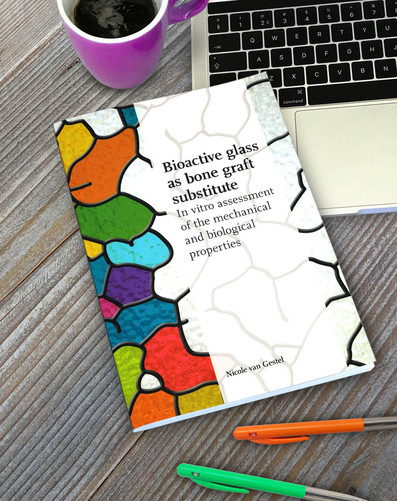
Bone is a versatile tissue, when damaged it can usually heal itself. However, there are cases where the healing is delayed or absent and a surgical intervention is needed to graft the bone. It has been reported that annually, 2.2 million of these surgical interventions, or bone graft procedures, are performed worldwide. The current gold standard grafting material is autologous bone, but its quality and availability varies among patients and a second surgery site is needed which entails additional risks. Donor bone is also considered, but the quality is reduced due to sterilization and preservation. As an alternative, biomaterials are being developed that fill bone defects and stimulate new bone formation. One of these materials are bioactive glasses that have shown good results in clinical studies and its bone bonding properties have been studied extensively. The specific S53P4 composition (23.0 wt% Na2O, 20.0 wt% CaO, 4.0 wt% P2O5 and 53.0 wt% SiO2) has shown good results in the one-stage treatment of osteomyelitis, with proven antibacterial properties, when used in a granular form. This granular form of the S53P4 bioactive glass has suboptimal handling properties for surgeons and therefore new formulations have been developed: so called putty materials. In these putty materials bioactive glass granules are incorporated in a synthetic binder, consisting of polyethylene glycols and glycerol, to establish an injectable material. In this thesis, the mechanical and biological properties of these S53P4 bioactive glass granules and putty materials have been assessed. It provides an overview of the load-bearing capacity of S53P4 bioactive glass granules and putty formulations. The loose granules can contribute to load-bearing in bones that are weakened by the creation of a cortical defect. The putty, in the current form, possesses mechanical properties and a degradation profile less suitable for load-bearing applications. The antibacterial properties of the newly developed putty formulations can also not be guaranteed yet. A better understanding of the antibacterial properties of the S53P4 bioactive glass in general is needed to enable new materials that can serve as antimicrobial bone graft substitutes based on bioactive glasses. In addition, degradation of the S53P4 granules has been studied and showed that osteoclasts can play a role in this degradation, in vitro. Whether this is representative for the in vivo situation remains to be studied. More complex 3D in vitro models may be used to study that in more detail and a first step of a new approach has been made.
Download Thesis